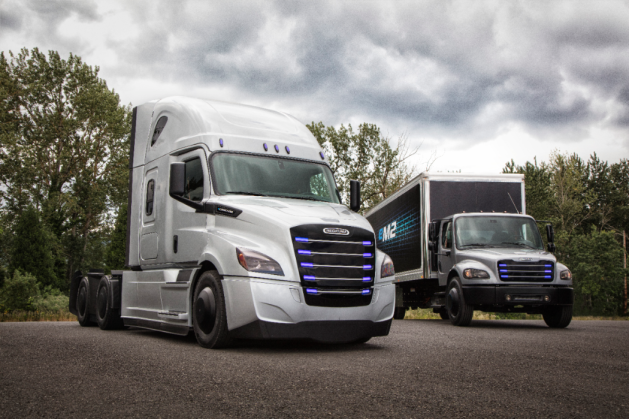DTNA oulines strategies for connectivity, automation and electrification
PORTLAND, Ore. – Connectivity, automation, and electrification were the themes of Daimler Trucks North America’s (DTNA) Capital Market and Technology Day.
Wilfried Achenbach, senior vice-president of engineering and technology, said those are more than buzzwords to Daimler, and are in fact the company’s three pillars.

On the connectivity front, DTNA announced new services that will be rolled out in the fourth quarter.
Detroit Connect Direct will provide a direct data feed to customers, presenting to them the data they want, when and how they want to receive it.
“It’s a service that will allow them to select what information they want, how frequently and when they want it delivered to their back end,” said Jason Krajewski, director of connectivity for DTNA.
Available data will include time and place, vehicle performance, driver behavior, and safety system performance. Krajewski said it will be delivered via a simple dashboard. It is currently running a pilot program.
“Customers we’ve put it in front of, really love that data,” Krajewski said.
Also in the fourth quarter, DTNA will allow customers to wirelessly pair their devices via Bluetooth to the truck’s embedded telematics platform. One benefit is that drivers can use any approved electronic logging device (ELD) app and connect directly to the truck’s hardware – avoiding the need to have additional ELD hardware installed.
“Via that Bluetooth connection, we will move hours-of-service data elements required for the ELD mandate to be accessible by authorized apps we work with our partners to release,” Krajewski said. “So, you can pair devices with the truck and have the flexibility to change those ELDs as needed and not have to be tied to hardware anymore. You can pair with our truck and use whatever platform you want to.”
The company is currently working with ELD partners and is in the process of authorizing their apps, in advance of a fourth quarter rollout.
“Many of our customers like to start building their own telematics ecosystems,” Krajewski said of the latest connected services being offered by the company. “A combination of in-cab device pairing and direct data feed really allows them to start that process.”
Krajewski also noted fleets are beginning to take advantage of remote parameter updates. Parameters including maximum vehicle speed, maximum cruise speed, idle shutdown time, and ambient shutdown temperatures, can be modified over the air in two to 10 minutes. This process used to require up a day of downtime when trucks had to be physically plugged into to make those changes, Krajewski explained. Over the air parameter updates were offered beginning in March.
“Customer adoption is starting to pick up now,” said Krajewski. “It’s a very new experience for people in our industry to do this remotely. The adoption curve is starting to ramp up now.”
On the automated driving front, Dr. Peter Vaughan Schmidt, head of truck strategy for Daimler, said the company continues to work on automated driving, noting its Inspiration Truck shown three years ago really kickstarted the industry’s push towards automation. However, Vaughan Schmidt insisted fully autonomous trucks are still some time away.
“Drivers, for the foreseeable future, will be a part of the equation and still in high demand,” Vaughan Schmidt said.
Daimler’s plan is to skip autonomous Level 3 and go straight from Level 2 to Level 4. Level 4 allows hands-free operation of the truck, but still requires a driver to be in the cab.
“The technology you bring into the truck is quite similar (between Level 3 and Level 4),” Vaughan Schmidt said. “But the value to our customers is much larger in Level 4.”
Level 4 represents a “highly automated truck,” in which the truck itself can manage all driving tasks in certain conditions.
Daimler also announced at the event its ambitions to become the world’s leader in producing electric trucks. It showed, for the first time, an electric eCascadia Class 8 truck and an eM2 medium-duty truck. Production dates were not released.
“We will be ready with series production vehicles at precisely the time it makes sense for our customers,” said Roger Nielsen, president and CEO of DTNA.
He also said Daimler will work with customers to understand how their businesses can benefit from electric vehicles, and will also provide expertise in understanding and implementing any charging infrastructure that’s required. The eCascadia will initially be aimed at drayage and regional pickup-and-delivery applications.
Later this year, Freightliner will be deploying its electric innovation fleet, which will see 30 eCascadias and eM2s put into freight hauling service with fleets.
“Today Daimler Trucks announced the broadest electrified commercial lineup in North America,” Nielsen said. “We are deploying the Freightliner Electric Innovation Fleet starting this year and our experts are helping our customers understand and deploy the needed infrastructure. It is our ambition to become the undisputed global leader in the electric truck business.”
For more info on the eCascadia and eM2, visit this page.
Have your say
This is a moderated forum. Comments will no longer be published unless they are accompanied by a first and last name and a verifiable email address. (Today's Trucking will not publish or share the email address.) Profane language and content deemed to be libelous, racist, or threatening in nature will not be published under any circumstances.